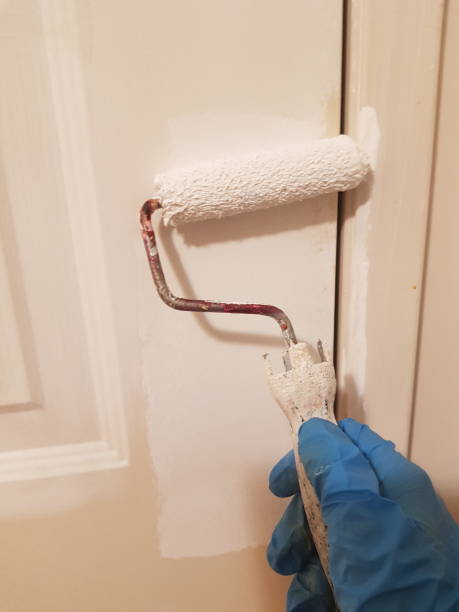Door painting is more than just a cosmetic touch-up; it’s a critical element in maintaining and enhancing the aesthetic appeal and durability of your home. Whether you’re updating the look of your front door, refreshing an interior door, or preparing for a sale, understanding the nuances of door painting in Lasalle CO can make a significant difference. This guide explores the best practices, materials, and techniques for door painting, ensuring that you achieve professional results.
Why Door Painting Matters
Enhances Curb Appeal
A freshly painted door can dramatically enhance the curb appeal of your home. It’s often the first thing visitors notice, and a well-chosen color can complement your home’s exterior design and increase its market value.
Protects the Door
Door painting isn’t just for looks. It provides a protective layer against the elements, such as rain, UV rays, and temperature fluctuations. Properly applied paint can prevent wood from warping, cracking, or rotting.
Personalization
Painting your door allows you to express your personality and style. Whether you prefer a bold, bright color or a classic, subdued hue, your choice can reflect your tastes and make a statement about your home.
Choosing the Right Paint for Doors
Types of Paint
- Oil-Based Paint: Known for its durability and smooth finish, oil-based paint is a traditional choice for doors. It dries slowly, which allows for a more even application, but requires solvents for cleanup.
- Latex Paint: Latex paint dries quickly and is easier to clean up. It’s less durable than oil-based paint but is a popular choice for interior doors due to its quick-drying properties.
- Enamel Paint: This type of paint provides a hard, glossy finish that’s highly resistant to scratches and stains. It’s suitable for both interior and exterior doors.
Paint Finishes
- Glossy: Offers a high shine and is easy to clean. Ideal for doors that need to stand out.
- Satin: Provides a softer sheen and is less reflective than glossy finishes. It’s good for areas with moderate traffic.
- Matte: Offers a non-reflective finish. It’s best for a more subtle look but can be harder to clean.
Preparing Your Door for Painting
Cleaning
Before painting, ensure the door is clean. Remove any dirt, grease, or grime with a mild detergent and water. Allow the door to dry completely before proceeding.
Sanding
Sanding is crucial for a smooth finish. Use fine-grit sandpaper to remove old paint and create a surface that the new paint can adhere to. For a metal door, sanding will also help to prevent rusting.
Priming
Priming is an essential step that prepares the door surface for painting. It ensures better paint adhesion and can help cover any imperfections. Use a primer suitable for the door material, whether it’s wood, metal, or fiberglass.
Painting Techniques
Tools You’ll Need
- Paintbrush: For detailed areas and edges.
- Roller: For covering larger surfaces.
- Spray Gun: Provides a smooth, even coat but requires careful technique.
Application
- First Coat: Apply the first coat of paint using long, even strokes. Ensure you cover all areas, including edges and corners.
- Drying Time: Allow the first coat to dry completely as per the manufacturer’s instructions before applying the second coat.
- Second Coat: Apply a second coat to ensure full coverage and a uniform finish.
Maintenance and Care
Regular Cleaning
Regularly clean your painted door with a soft cloth and mild detergent to keep it looking fresh. Avoid abrasive cleaners that can damage the paint.
Touch-Ups
Touch up any chips or scratches as soon as they appear to maintain the door’s appearance and protective layer.
FAQs
How often should I repaint my door?
The frequency of repainting depends on factors like door location, exposure to the elements, and paint quality. Generally, exterior doors should be repainted every 3-5 years.
Can I paint over existing paint?
Yes, you can paint over existing paint. However, ensure the old paint is clean and well-sanded. If the old paint is peeling, it should be removed before applying a new coat.
What is the best temperature for painting a door?
The ideal temperature for painting is between 50°F and 85°F (10°C and 29°C). Extreme temperatures can affect the drying and curing of the paint.
Can I use leftover paint for future touch-ups?
Yes, you can use leftover paint for touch-ups. Store it in a cool, dry place and ensure the lid is tightly sealed to prevent it from drying out.
Conclusion
Best door painting is a practical and aesthetically pleasing way to enhance your home. By selecting the right paint, preparing the surface properly, and applying the paint with care, you can achieve a professional finish that lasts for years. Whether you’re painting an exterior door to boost curb appeal or refreshing an interior door for a new look, following these expert tips will help you get the best results.




